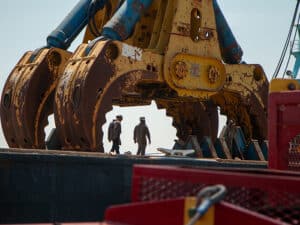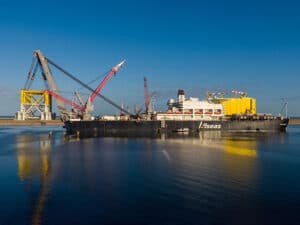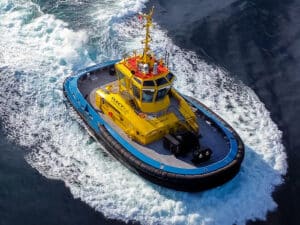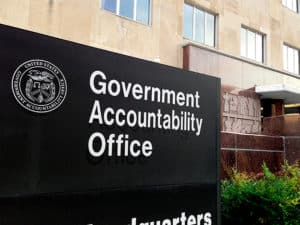
Navy: Loss of Bonhomme Richard “completely preventable”
Written by Nick Blenkey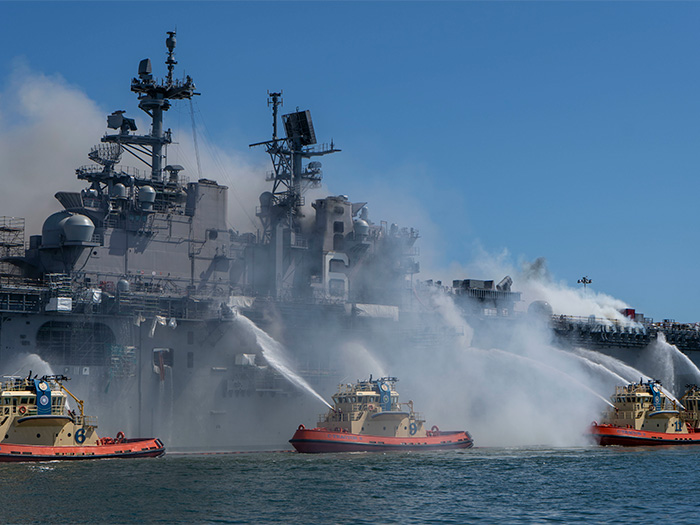
Despite days long efforts to fight the Bonhomme Richard fire, damage was so extensive that it was decided to decommission the ship [U.S. Navy photograph]
The U.S. Navy yesterday released two reports into the fire aboard USS Bonhomme Richard (LHD 6) on July 12, 2020, that caused such extensive damage that it was subsequently decided to decommission the vessel. The reports released are those off the results of a U.S. Pacific Fleet Command Investigation and a Major Fires Review commissioned by the Vice Chief of Naval Operations that examined all major fires in the Navy over the last 12 years.
Even in the redacted form released by the Navy, the reports pull few punches.
The Navy convened the PACFLT command investigation on USS Bonhomme Richard to specifically examine all causal and contributing factors to the fire that resulted in the total loss of the ship.
There were four categories of causal factors that allowed for the accumulation of significant risk and led to an ineffective fire response: the material condition of the ship, the training and readiness of the ship’s crew, the integration between the ship and supporting shore-based firefighting organizations, and the oversight by commanders across multiple organizations. The command investigation also concluded “a lack of familiarity with requirements and procedural noncompliance at multiple levels of command” contributed to the loss of ship.
Vice Chief of Naval Operations Adm. Bill Lescher emphasized the Navy’s commitment to making urgent and necessary changes to correct the deficiencies and related root causes that led to the Bonhomme Richard fire.
“The loss of this ship was completely preventable,” said Lescher. “And the Navy is executing a deliberative process that includes taking appropriate accountability actions with respect to personnel assigned to Bonhomme Richard and the shore commands designed to support the ship while moored at Naval Base San Diego.”
Lescher designated the commander of the U.S. Pacific Fleet as the Consolidated Disposition Authority to handle administrative and disciplinary actions relating to military members. Recommendations concerning civilian employees will be forwarded to the relevant supervisor for action.
ARSON CHARGE
Based on a separate criminal investigation, Commander, U.S. 3rd Fleet preferred charges against one sailor who is charged with aggravated arson and hazarding a vessel. A preliminary hearing for the sailor is scheduled for mid-November.
FINDINGS AND OPINIONS
The PACFLT investigation yielded more than 1,000 findings of fact associated with the fire resulting in 242 opinions based on those findings, 139 recommendations for corrective action by various organizations at levels throughout the Navy, and listing 36 individuals recommended for accountability actions, some of whom are named in the report and some whose names have been redacted.
Here’s just one brief extract from the “Opinions” chapter of the report:
“Tracing the causal nexus to this fire and the loss of Bonhomme Richard starts at the unit level and expands to the oversight, programmatic, policy and resourcing considerations that, at a minimum, contributed to this incident. This section provides opinions and analysis across this entire spectrum. Overall, there were four focus areas that drove the final outcome:
detection capability, communications equipment, shipboard firefighting systems, miscellaneous gear clutter, and combustible material accumulation. To illustrate the extent of degradation, on the morning of the fire, 87% of the ship’s fire stations remained in inactive equipment maintenance status.
- Training and Readiness. The training and readiness of Ship’s Force was marked by a pattern of failed drills, minimal crew participation, an absence of basic knowledge on firefighting in an industrial environment, and unfamiliarity on how to integrate supporting civilian firefighters. To illustrate this point, the crew had failed to meet the time standard for applying firefighting agent on the seat of the fire on 14 consecutive occasions leading up to 12 July 2020.
- Shore Establishment Support. The integration and support expected by the shore establishment did not adhere to required standards. Southwest Regional Maintenance Center (SWRMC) did not meet their requirements associated with fire safety and, in doing so, failed to communicate risk to leadership while facilitating unmitigated deviations from technical directives. Naval Base San Diego (NBSD) failed to ensure its civilian firefighters were familiar with Navy vessels on the installation, verify they were trained to respond to a shipboard fire, or effectively practice how to support
- Oversight. Ineffective oversight by the cognizant Commanders across various organizations permitted their subordinates to take unmitigated risk in fire preparedness. A significant source of this problem was an absence of codification of the roles and responsibilities expected by each organization in their oversight execution.
Common to all four focus areas was a lack of familiarity with key policies and requirements along with procedural non-compliance at all levels of command from the unit level to programmatic, policy, and resourcing decisions.”
MERITORIOUS PERFORMANCE OF DUTIES
On the other side of the coin, the report recognized the “bravery, ingenuity, and resourcefulness in the actions of Sailors across the San Diego waterfront and others who had a role in the response,” and identified 10 meritorious performance recommendations for actions taken during the firefighting efforts.
MAJOR FIRES REVIEW
Alongside the Bonhomme Richard investigation results, the Navy also released the results of the Major Fires Review, ordered in January 2021 by the VCNO. A comprehensive historical review of major fires aboard U.S. Navy ships, the Major Fires Review aimed at identifying recurring trends in the causal factors of 15 major shipboard fires over the past 12 years.
The expansive review included 12 major findings contributing to a current state of elevated risk for ships in maintenance availabilities with seven strategic recommendations for corrective actions.
The Major Fires Review revealed that ineffective learning, the persistence of underlying weaknesses in shipboard watchstanding standards, hazardous and combustible material stowage, and training were the primary issues contributing to a lack of enduring change and in shipboard fires.


